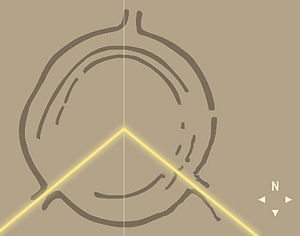I take it, Jon, that you have stumbled on this independently. However, I think it goes back to John Michell (or one of his acolytes) originally and certainly it was discussed on the Graham Hancock website.
I didn't know that! I have one of Hancock's books but haven't come across this one before.
There are tales of Stonehenge being 'special' because of the sunset winter solstice/sunrise summer solstice being the same alignment, but when I did the figures it turned out that there are vast numbers of places where that alignment is the same: Having the solstices aligned is quite likely wherever you do it (especially the nearer you get to the equator)
Jon, I couldn't (as per usual) follow your technical arguments but I would be obliged if you would take up the Great 51 Degree Debate since it might be critical. First of all, could you give an account of how you did come to stumble upon it?
Apologies for this. I often forget to explain it fully. I stumbled across it some time ago but didn't think it important at the time. I was using a sunset calculator to see where else alignments of this type might be special. If it's of interest, I'll list them. But only when I did the list did I notice that only the Stonehenge latitude had this special feature. So I recalculated to see if anywhere else had it that wasn't on the list: There was nowhere else.
If you know where North is, you can draw a line showing which way to look. But you'll also need to know what angle to look at. If you draw a circle of seven equal parts, starting at your North line, then place a stick pointing towards North and a stick pointing to the first division, tie the two together, you have an angle: If you raise the stick from the flat, you'll find it points to the North Star.
This only happens at the latitude of Stonehenge. Stonehenge is 1/7th round the world from the equator (at a latitude of 51 degrees: 51/360 = 1/7)
It's perhaps not a coincidence that Stonehenge had a circle (the Aubrey Holes) composed of seven parts, each with seven intermediate markers (making a total of 56 Aubrey holes)
It's also perhaps not a coincidence that Goseck in Germany also has these same lines, but each 1/7th from south rather than north and with one entrance looking North. By comparison, Stonehenge has one entrance looking South and one at 1/7th from North).

But there's something really special you can do with the Stonehenge arrangement that you can't do with the Goseck arrangement. Would take too long to go into it here.
Back to Stonehenge: If you wait until sunrise of the summer solstice, you'll also find that sunrise also occurs along exactly the same 1/7th line (it's 51 degrees from north to the Heel Stone). The same thing is true at Goeseck: The sunrise at winter solstice is the same line, more or less, as the sunset at summer solstice.
Again, this only happens at the latitude of Stonehenge. Try it anywhere else and it will not work: The further north you go, the higher the polar axis is in the sky, but at the same time, the angle of solstice sunrise (from North) gets lower.
If you go South, the polar axis gets lower in the sky, but the angle of solstice sunrise gets higher. So this special coincidence of the axes only occurs at this latitude.
Is that any good as explanation?
All the best
Jon
